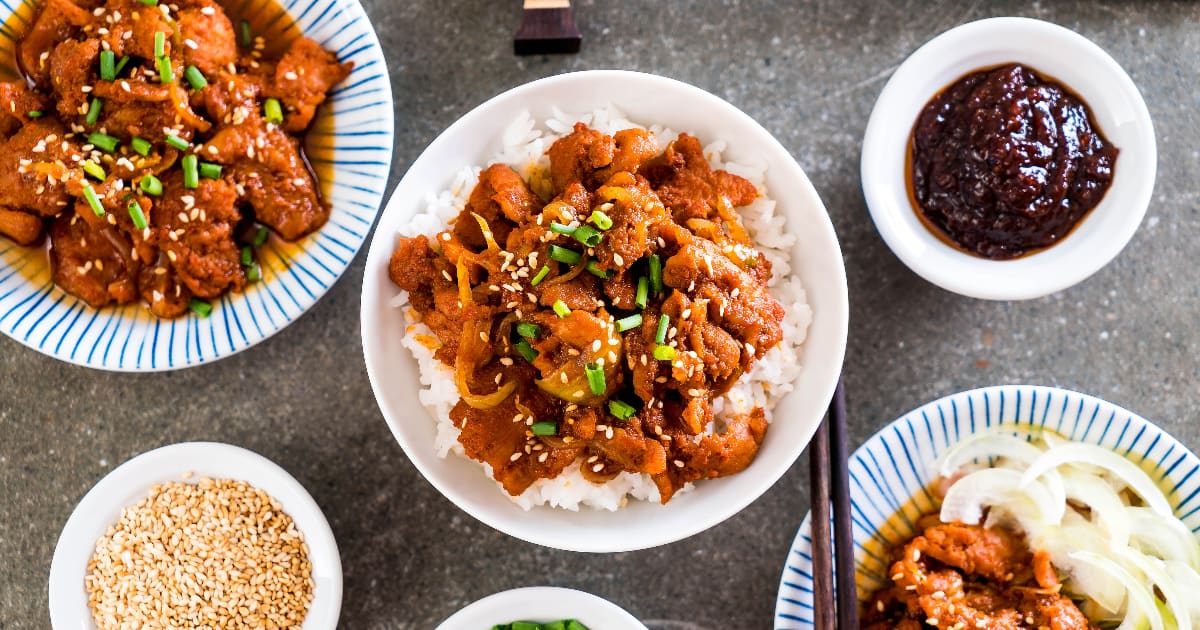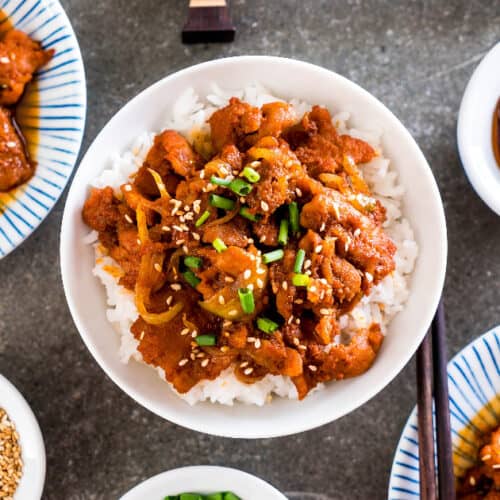Gochujang bulgogi is a Korean grilled meat dish made with a sweet and spicy marinade containing the key ingredient gochujang (Korean red chili paste). It consists of thin slices of meat like pork, beef, or chicken that are marinated in a sauce with gochujang, garlic, ginger, soy sauce, sugar, and other ingredients.

The term "bulgogi" means "fire meat" in Korean, referring to the cooking method of grilling the marinated meat over high heat. The "gochujang" in the name refers to the fact that gochujang is a key component of the marinade sauce.
Gochujang is a thick, sticky condiment made from fermented soybeans, glutinous rice, salt, and chili powder. It has a sweet, savory, and spicy flavor profile. The gochujang gives the bulgogi marinade a bold, tangy heat and lends the dish its signature red hue.
There are different variations of gochujang bulgogi using different types of meat:
- Pork bulgogi (dwaeji-bulgogi or jeyuk-bokkeum): The most common and traditional version uses a thinly sliced pork belly or shoulder.
- Beef bulgogi (soegogi-bulgogi): Uses ribeye, sirloin, or other beef cuts.
- Chicken bulgogi (dak-bulgogi): Made with boneless chicken thighs or breasts.
Gochujang Bulgogi Marinade Ingredients
The marinade is what really makes gochujang bulgogi stand out. It infuses the meat with complex sweet, savory and spicy flavors. Here are the key ingredients that go into a typical gochujang bulgogi marinade:
- Gochujang (Korean red chili paste): The star ingredient that gives the dish its signature spicy, sweet and umami flavors.
- Gochugaru (Korean chili flakes): Adds a pure hit of chili heat.
- Soy sauce: Provides saltiness and savoriness.
- Sugar or honey: Balance out the spice and contribute sweetness.
- Rice wine: Called mirin in Korean, it lends a subtle sweet tang.
- Garlic and ginger: Fundamental aromatics in Korean cuisine, they add lots of flavor.
- Sesame oil: Distinctive nutty aroma and flavor.
- Asian pear, apple or Korean plum syrup: Sweet and slightly acidic to tenderize the meat.
- Onion and scallions: Extra savory and aromatic flavors.
- Black pepper: A little bit of spice.
The exact ingredients and ratios vary between recipes, but this covers the basics of a gochujang bulgogi marinade.
How to Make Gochujang Bulgogi
Making gochujang bulgogi at home is easy to do in 3 simple steps:
1. Prepare the Meat
- For beef bulgogi, use ribeye, sirloin or flank steak. For pork, opt for pork shoulder or belly. Slice the meat against the grain into thin, bite-sized pieces.
- Partially freezing the meat for 30 mins makes it easier to slice thinly.
- Place the sliced meat in a large bowl or resealable plastic bag.
2. Make the Marinade
- In a blender or food processor, combine all the marinade ingredients like gochujang, soy sauce, garlic, ginger, Asian pear etc.
- Pulse to a smooth paste consistency. Taste and adjust seasoning if needed.
3. Marinate and Cook
- Pour the marinade over the meat. Make sure all the pieces are fully coated.
- Marinate for 1-8 hours in the fridge (the longer the better).
- Cook on a grill pan or cast iron skillet over high heat until caramelized and cooked through.
- alternatively cook over charcoal the traditional way.
- Garnish with sesame seeds and scallions before serving.
Serving Suggestions for Gochujang Bulgogi
Gochujang bulgogi is highly versatile and can be served in different ways:
- On a bed of steamed white or brown rice in a bowl, along with banchan side dishes.
- Wrapped in lettuce or perilla leaves with ssamjang dipping sauce and other veggies.
- Stir-fried with glass noodles (chapchae) or ramen noodles.
- In tacos, burritos or on nachos.
- Over a bowl of bibimbap rice with veggies and egg.
- Tossed with stir-fried vegetables like mushrooms, zucchini etc.
- In fusion rice bowls or on pizza.
Mix and match it with other ingredients to create your own perfect gochujang bulgogi meal! It also stores well for meal prepping lunches and dinners.
How to Buy Gochujang for Bulgogi
To make authentic gochujang bulgogi, it's important to use quality gochujang. Here are some tips for purchasing it:
- Check Asian grocery stores catering to Korean customers. This is the best place to find authentic brands.
- Look for well-known Korean brands like Chung Jung One, Sempio, CJ etc. Avoid China-made ones.
- Check the ingredients - it should contain chili powder, glutinous rice powder, fermented soybean powder etc.
- The color should be a vivid red. Avoid brownish discolored ones.
- Buy the type marked "medium hot". Mild is too bland, extra hot can be overwhelming.
- Refrigerate after opening and use within 6 months. The fermented flavors decline over time.
- If unavailable locally, buy good quality gochujang online.
Getting authentic gochujang is key for making the perfect marinade and genuine tasting gochujang bulgogi.
How Spicy is Gochujang Bulgogi?
The spiciness of gochujang bulgogi can vary a lot depending on the amount and type of gochujang used in the recipe. Here are some tips to control the heat level:
- Start with a smaller amount of gochujang, like 2-3 Tbsp per 1 lb meat. You can always add more later.
- Add some gochugaru (Korean red chili flakes) for extra spice. omit to make it milder.
- Use less chili powder if the gochujang itself is the spicy component.
- Balance with more sugar to offset the chili heat.
- Marinate for less time if it gets too spicy. The flavors intensify over time.
- Buy "mild" gochujang or use a weaker brand to control the spice level.
- Serve with cooling, creamy items like yogurt or ranch dressing to balance the heat.
Adjust the gochujang quantity based on your own tolerance, or the preferences of your guests if cooking for a crowd.
Tips for Making the Best Gochujang Bulgogi
Here are some helpful tips to make restaurant-quality gochujang bulgogi at home:
- Slice the meat thinly for the best texture - it cooks fast and absorbs the marinade better.
- Marinate for 1-8 hours for maximum flavor infusion (or overnight if you have time).
- Use a very hot pan or grill and cook in batches to get nice charring without steaming the meat.
- Rest for 5 minutes before slicing to allow juices to redistribute.
- Add sliced onion to the pan towards the end for extra flavor and texture.
- Toast the sesame seeds before using as garnish for more nutty flavor.
- Use Korean short grain rice like calrose rice for the right texture with bulgogi.
- Include banchan side dishes like kimchi, danmuji etc for a traditional Korean meal.
Getting the meat, marinade, cooking method and serving style right is key to authentic, restaurant-quality gochujang bulgogi you can proudly serve to any guest.
Variations for Gochujang Bulgogi
The basic gochujang marinade can be tweaked into different flavor variations:
- Fruit bulgogi: Use pineapple, mango, pear, apple or Korean plum syrup.
- Yogurt bulgogi: Add 2-3 Tbsp yogurt to tenderize meat and provide tang.
- Bulgogi lettuce wraps: Use butter or romaine lettuce leaves for wrap-style bulgogi tacos.
- Bulgogi rice bowl: Top a bowl of rice with bulgogi, kimchi, fried egg etc.
- Bulgogi pasta: Toss cooked bulgogi with noodles or pasta.
- Bulgogi cheesesteak: Use bulgogi in a Philly cheesesteak sandwich.
- Bulgogi nachos: Top nacho chips with bulgogi, cheese, beans etc.
- Bulgogi pizza: Use it as a pizza topping instead of pepperoni or sausage.
Feel free to get creative with ingredients like fruits, vegetables, cheeses etc while keeping the core gochujang flavors intact!
FAQs About Gochujang Bulgogi
What is the best meat for gochujang bulgogi?
Traditionally, thinly sliced pork belly is most commonly used. But beef cuts like ribeye, sirloin and flank steak also work very well. Boneless chicken thighs or breasts can be used too.
Does bulgogi need to marinate overnight?
It's ideal but not required. You can marinate for just 1-2 hours. Overnight gives the deepest flavor infusion though.
Can you make bulgogi without gochujang?
You can try substituting gochujang with sriracha or miso paste, but it won't taste authentic. Gochujang has a unique flavor.
What is the white stuff served with bulgogi?
It's called banana leaf lettuce or sesame leaf lettuce. The bulgogi wraps are served over these lettuce leaves.
What dipping sauce is served with bulgogi?
Ssamjang, a spicy thick dipping sauce, is traditionally served with lettuce wrap bulgogi. It's made with gochujang, doenjang and other ingredients.
Conclusion
Gochujang bulgogi is a beloved Korean BBQ dish with a sweet, savory and spicy marinade that infuses grilled meat with tons of flavor. While traditional versions use pork, beef or chicken work great too. With authentic gochujang as the star ingredient, it can be made easily at home for a taste of Korea without leaving your kitchen. Serve it over rice, with noodles or lettuce wraps for a hearty, comforting meal with a kick of heat. Once you try it, this bulgogi is sure to become a regular in your dinner rotation.

Gochujang Bulgogi Recipe
Ingredients
- 1 lb thinly sliced pork belly, pork shoulder, beef ribeye or flank steak
- 1/4 cup sliced yellow onion
- 2 Tbsp vegetable oil
For the marinade:
- 3 Tbsp gochujang (Korean red chili paste)
- 1 Tbsp gochugaru (Korean red chili flakes)
- 2 Tbsp soy sauce
- 2 Tbsp brown sugar
- 1 Tbsp minced garlic
- 1 Tbsp grated ginger
- 1 Tbsp mirin (or rice wine)
- 1 Tbsp sesame oil
- 1 Asian pear, grated
- 2 scallions, cut into sections
Instructions
- Slice the meat thinly across the grain. Place in a large bowl.
- Make the marinade: In a blender or food processor, combine the gochujang, gochugaru, soy sauce, brown sugar, garlic, ginger, mirin, sesame oil and grated Asian pear. Puree until smooth.
- Pour the marinade over the sliced meat. Add the sliced onion and scallions. Mix well until the meat is fully coated.
- Cover and marinate for 1-8 hours in the refrigerator.
- Heat a cast iron skillet over high heat. Add 1 Tbsp oil and half of the meat mixture. Cook for 2-3 minutes per side until caramelized.
- Transfer to a plate and repeat with remaining 1 Tbsp oil and meat.
- Garnish with sesame seeds and scallions before serving. Enjoy with rice and banchan!

